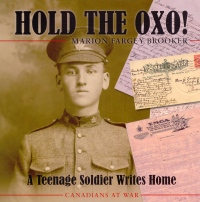| ________________
CM . . . . Volume XVIII Number 10 . . . . November 4, 2011
excerpt:
Hold the Oxo! tells what the First World War was like from the perspective of Jim Fargey through letters written to his family. Fargey enlisted in the Canadian army at age 17 in July 1915, and died on October 16, 1916, as a result of wounds received during the Battle of the Somme. A fine history of the war binds the letters together and makes Hold the Oxo! very useful for classroom use. It lends itself to numerous questions and topics about war and the needless waste of young lives. There are 12 chapters of varying length from three to seventeen pages. Most are very short. Jim's letters deal with the boredom of military life in the trenches. Simple pleasures, such as a baseball game, assumed considerable importance because they were such a relief from the fear and tension faced by all soldiers in his situation. In one letter, for example, Jim asks his mother to send him some cocoa, but not to send OXO (hence the use of OXO in the book's title) because the soldiers don't use it much. The letters also mention many of the routine farming chores Jim assumed were being done by his family and that he was regretfully missing. The author of Hold the Oxo!, Marion Fargey Brooker, is the niece of Jim Fargey, and she tells his story with great feeling. Her book gives an accurate and meaningful account of the war. As a result, one can't help but sympathise with the young men who volunteered to fight in a war they didn't really comprehend and for the many, like Jim, who never came home. Brooker has considerable experience in writing for young readers. Her dramas and stories have been heard on education radio for grades 1 to 12, and she has written several books. Her writing is clear and easy to understand and perfect for the intended readership. While the assassination of Archduke Franz Ferdinand, heir to the throne of Austria-Hungary, is mentioned as the reason the war began in 1914, the book barely mentions the complicated set of military alliances that resulted in so many nations becoming involved. "The fine print in alliances made years before were read and re-read" is not sufficient to explain why this horrible tragedy happened. A sidebar pointing out the member nations of The Triple Entente and Triple Alliance could have sufficed. There are a number of useful teaching aids in Hold the Oxo! . The book contains an Index, lists of Websites and Resources, plus a Timeline with important dates of relevance, including February 18, 2010, when the last known Canadian survivor of the First World War died. It has a very fine Glossary. Hold the Oxo! also has many black and white illustrations distributed all through the book. These include a number of World War One cartoons by Bruce Bairnsfather who managed to provide some humour in an otherwise deadly business. There are, in addition, many sidebars with various titles, such as "In the Trenches" and "Lest We Forget." One of the former compares the Lee Enfield Rifle, used by the British Army, with the Ross Rifle used by the Canadians. A map of the western front where the Canadian troops fought would have been useful. Highly Recommended. Thomas F. Chambers, a retired college teacher, lives in North Bay, ON.
To comment
on this title or this review, send mail to cm@umanitoba.ca.
Copyright © the Manitoba Library Association. Reproduction for personal
use is permitted only if this copyright notice is maintained. Any
other reproduction is prohibited without permission.
NEXT REVIEW |
TABLE OF CONTENTS FOR THIS ISSUE
- November 4, 2011.
AUTHORS |
TITLES |
MEDIA REVIEWS |
PROFILES |
BACK ISSUES |
SEARCH |
CMARCHIVE |
HOME |
